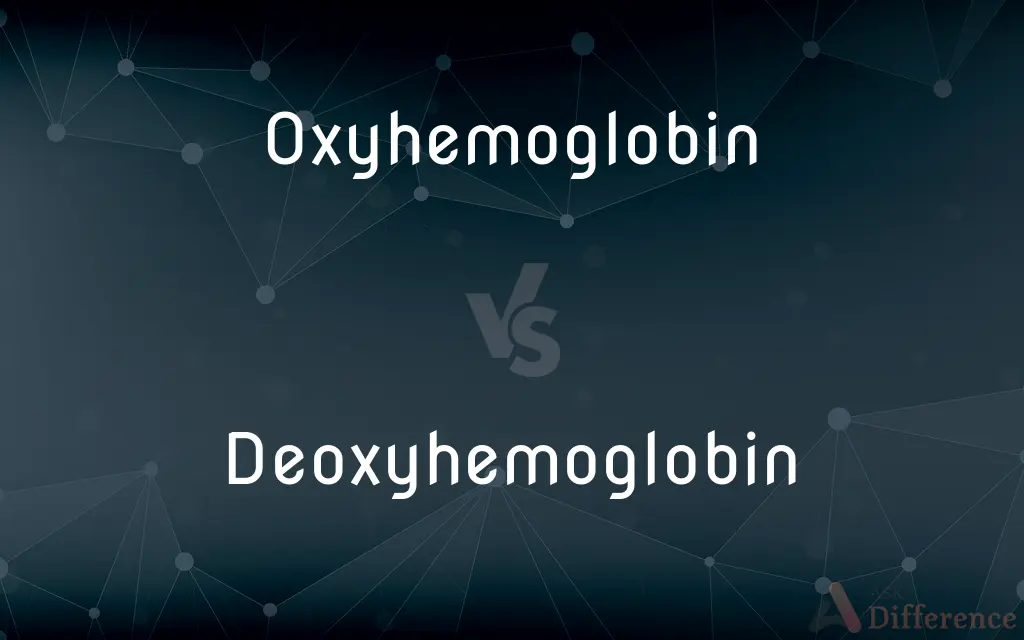Oxyhemoglobin vs. Deoxyhemoglobin — What's the Difference?
By Tayyaba Rehman & Urooj Arif — Updated on March 12, 2024
Oxyhemoglobin carries oxygen in the blood, while deoxyhemoglobin lacks oxygen, highlighting their roles in respiratory processes.

Difference Between Oxyhemoglobin and Deoxyhemoglobin
Table of Contents
ADVERTISEMENT
Key Differences
Oxyhemoglobin is formed when hemoglobin binds to oxygen in the lungs, facilitating oxygen transport throughout the body. Whereas deoxyhemoglobin results when oxyhemoglobin releases its oxygen to tissues, reverting to its oxygen-free state. This exchange is crucial for cellular respiration and energy production.
Oxyhemoglobin exhibits a bright red color due to its oxygen-rich composition, making arterial blood appear red. On the other hand, deoxyhemoglobin, lacking oxygen, gives venous blood a darker red hue, indicating its role in transporting carbon dioxide and other metabolic by-products back to the lungs.
The affinity of hemoglobin for oxygen is influenced by various factors, including pH and temperature. Oxyhemoglobin forms more readily at higher pH levels and lower temperatures, promoting oxygen uptake in the lungs. Conversely, deoxyhemoglobin is favored at lower pH levels and higher temperatures, found in active tissues, enhancing oxygen release.
The Bohr effect describes how carbon dioxide and hydrogen ions affect hemoglobin's oxygen affinity. Oxyhemoglobin's affinity decreases in the presence of carbon dioxide and hydrogen ions, facilitating oxygen release. Whereas, in the lungs, lower carbon dioxide levels and higher pH promote the formation of oxyhemoglobin, aiding in oxygen uptake.
Oxyhemoglobin and deoxyhemoglobin play pivotal roles in the oxygen-carbon dioxide exchange during respiration, demonstrating hemoglobin's versatility in oxygen transport and carbon dioxide removal, essential for maintaining homeostasis.
ADVERTISEMENT
Comparison Chart
Oxygen Content
High (bound to oxygen)
Low (oxygen released)
Color
Bright red (due to oxygen binding)
Darker red (lacks oxygen)
Role in Respiration
Transports oxygen from lungs to tissues
Carries carbon dioxide and by-products to lungs
Affinity Influences
Higher at higher pH and lower temperatures
Increased at lower pH and higher temperatures
Association with Bohr Effect
Decreased affinity in presence of CO2 and H+ (promotes oxygen release)
Affinity not directly affected by CO2 and H+
Compare with Definitions
Oxyhemoglobin
Oxygen-rich hemoglobin.
Oxyhemoglobin carries oxygen from the lungs to body tissues.
Deoxyhemoglobin
Darker red in color.
Venous blood appears darker due to the presence of deoxyhemoglobin.
Oxyhemoglobin
Forms in the lungs.
Oxyhemoglobin formation occurs as blood passes through the lung capillaries.
Deoxyhemoglobin
Oxygen-depleted hemoglobin.
Deoxyhemoglobin returns to the lungs to pick up oxygen.
Oxyhemoglobin
High oxygen affinity.
Oxyhemoglobin demonstrates a high affinity for oxygen at the alveolar interface.
Deoxyhemoglobin
Lower oxygen affinity.
Deoxyhemoglobin has a lower affinity for oxygen, facilitating its release.
Oxyhemoglobin
Bright red in color.
The bright red color of arterial blood is due to oxyhemoglobin.
Deoxyhemoglobin
Results from oxygen release.
Deoxyhemoglobin forms when oxygen is delivered to body tissues.
Oxyhemoglobin
Releases oxygen to tissues.
Oxyhemoglobin releases oxygen to meet the metabolic demands of tissues.
Deoxyhemoglobin
Transports carbon dioxide.
Deoxyhemoglobin helps in transporting carbon dioxide back to the lungs.
Oxyhemoglobin
A bright-red chemical complex of hemoglobin and oxygen that transports oxygen to the tissues.
Deoxyhemoglobin
The form of hemoglobin without bound oxygen.
Oxyhemoglobin
(American spelling) oxyhaemoglobin
Oxyhemoglobin
The bright red hemoglobin that is a combination of hemoglobin and oxygen from the lungs;
Oxyhemoglobin transports oxygen to the cells of the body
Common Curiosities
How is deoxyhemoglobin formed?
Deoxyhemoglobin forms when oxyhemoglobin releases its oxygen to the body's tissues, reverting to its oxygen-free state.
Why is oxyhemoglobin red?
Oxyhemoglobin is red due to the presence of oxygen, which alters its molecular structure and hence its color.
What role does deoxyhemoglobin play in the body?
Deoxyhemoglobin plays a crucial role in transporting carbon dioxide and other metabolic by-products from tissues back to the lungs.
How does the Bohr effect influence oxyhemoglobin?
The Bohr effect describes how the presence of carbon dioxide and hydrogen ions decrease oxyhemoglobin's oxygen affinity, promoting oxygen release to tissues.
What is the color difference between oxyhemoglobin and deoxyhemoglobin?
Oxyhemoglobin is bright red due to oxygen binding, while deoxyhemoglobin is darker red, reflecting its oxygen-depleted state.
What is the significance of the color change in hemoglobin?
The color change indicates hemoglobin's oxygenation status, with bright red signifying oxyhemoglobin and darker red indicating deoxyhemoglobin.
What happens to oxyhemoglobin at the tissue level?
At the tissue level, oxyhemoglobin releases its bound oxygen to meet the metabolic demands of cells, becoming deoxyhemoglobin.
How does the presence of carbon dioxide affect hemoglobin's affinity for oxygen?
Carbon dioxide decreases hemoglobin's affinity for oxygen, promoting the release of oxygen from oxyhemoglobin to tissues, a part of the Bohr effect.
What is oxyhemoglobin?
Oxyhemoglobin is hemoglobin bound to oxygen, primarily found in arterial blood, and responsible for oxygen transport from the lungs to tissues.
Can deoxyhemoglobin bind to oxygen?
Yes, deoxyhemoglobin can bind to oxygen, converting back to oxyhemoglobin, primarily in the lungs.
What is the clinical relevance of measuring oxyhemoglobin and deoxyhemoglobin levels?
Measuring levels of oxyhemoglobin and deoxyhemoglobin is crucial in assessing oxygenation status and respiratory function in clinical settings.
Why is deoxyhemoglobin important for carbon dioxide transport?
Deoxyhemoglobin plays a key role in carbon dioxide transport by carrying CO2 and other by-products from tissues back to the lungs for exhalation.
What conditions favor the formation of oxyhemoglobin?
Conditions such as higher pH and lower temperatures favor oxyhemoglobin formation, enhancing oxygen uptake in the lungs.
How does pH affect oxyhemoglobin and deoxyhemoglobin?
A higher pH increases oxyhemoglobin's affinity for oxygen, facilitating its formation, while a lower pH promotes deoxyhemoglobin formation by encouraging oxygen release.
How does temperature affect oxyhemoglobin and deoxyhemoglobin?
Lower temperatures increase oxyhemoglobin's affinity for oxygen, promoting its formation, whereas higher temperatures favor deoxyhemoglobin by facilitating oxygen release.
Share Your Discovery

Previous Comparison
Brachiosaurus vs. Apatosaurus
Next Comparison
Invention vs. InnovationAuthor Spotlight
Written by
Tayyaba RehmanTayyaba Rehman is a distinguished writer, currently serving as a primary contributor to askdifference.com. As a researcher in semantics and etymology, Tayyaba's passion for the complexity of languages and their distinctions has found a perfect home on the platform. Tayyaba delves into the intricacies of language, distinguishing between commonly confused words and phrases, thereby providing clarity for readers worldwide.
Co-written by
Urooj ArifUrooj is a skilled content writer at Ask Difference, known for her exceptional ability to simplify complex topics into engaging and informative content. With a passion for research and a flair for clear, concise writing, she consistently delivers articles that resonate with our diverse audience.














































